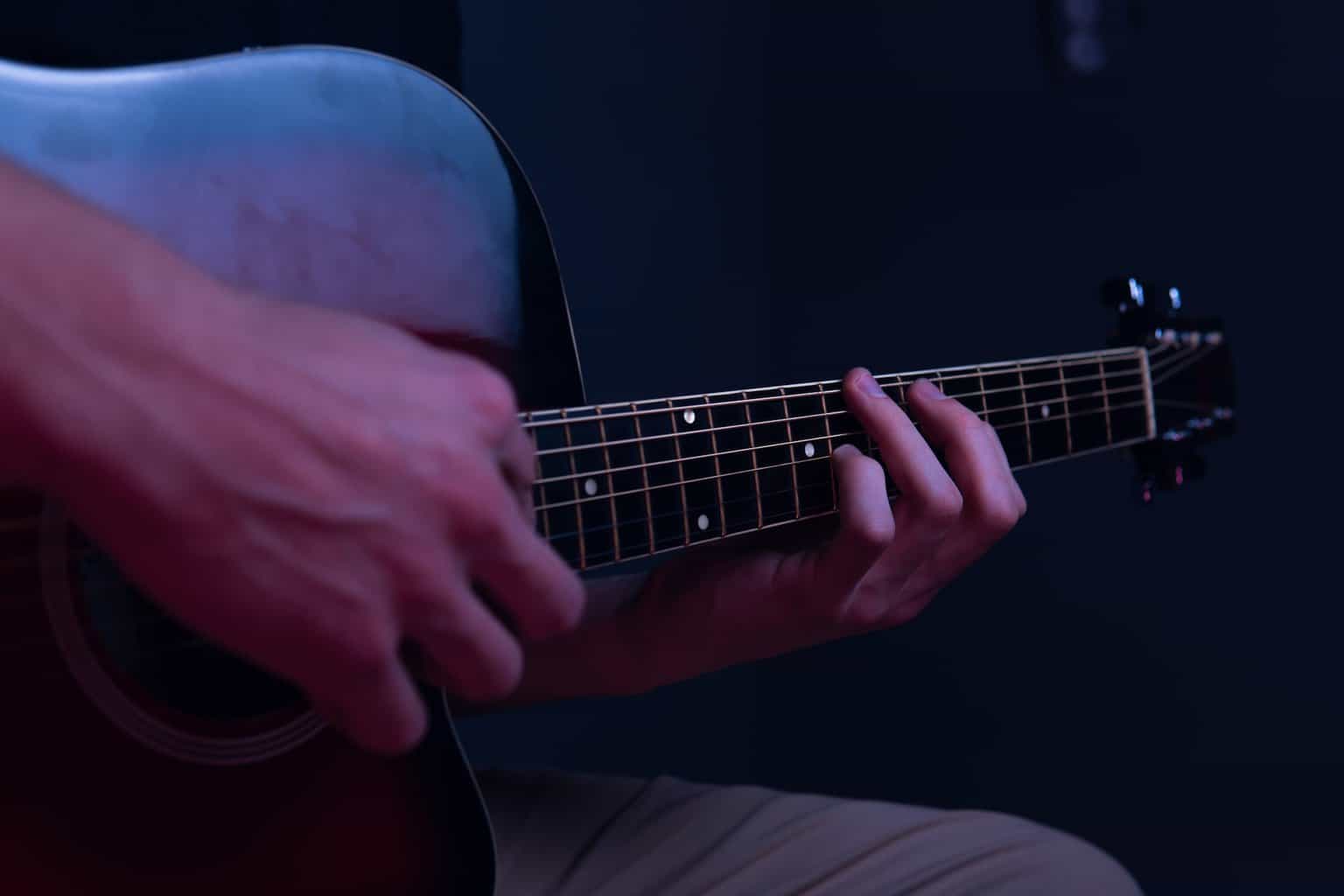“Not all chords are made the same, some are harder than others”.
I wish I was told that back in the day; this cold fact generated a big clash with my beginner expectations.
We want to be able to play every song that comes to mind and we suddenly find ourselves empty of tools. Yet, there is a core of chords that make up most Western music.
Yes, you can play hundreds or even thousands of songs with just two or three handfuls of chords. That will kickstart your playing and help you cover a vast sonic ground with minimal effort.
The best easy chords to kickstart your playing are the CAGED chords in combination with cowboy chords (also known as first-position or open chords). It’s very important to learn these chords first because they are the backbone of modern Western music and will allow you to play countless songs.
Your playing skills are about to take a great leap toward proficiency; you’re about to unlock a pathway to playing many songs in little time.
So, hold your golden ticket, and let’s get going with the adventure.
Buckle up because here we go!
1. CAGED Chords
The CAGED system is, arguably, the backbone of Western music. Yes, with only a handful of chords, you can play many, many songs.
This is not only because they are among the easiest chords you can play on a guitar, but also because with their shapes, you can form virtually any other chord you want on the fretboard.
Moreover, the CAGED system can help you understand your guitar’s fretboard much deeper. Yes, you can cover it entirely by knowing a few shapes and moving them around the fretboard.
So, to begin with, the name “CAGED” has nothing to do with an actual cage, it is an acronym formed by the chords we’re talking about. So, the CAGED system includes the C, A, G, E, and D chords.
Let’s take a look at the chords included in this system:

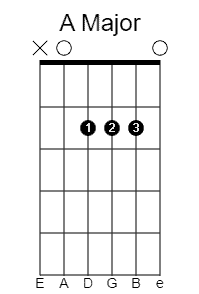
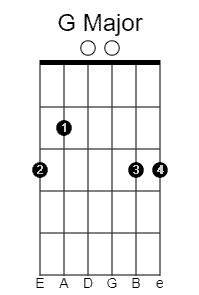
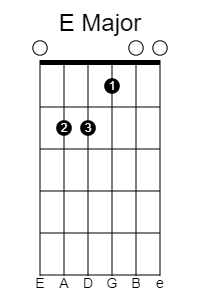
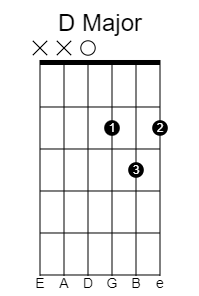
Now, with these chords’ shapes, we can create a plethora of other chords by moving the exact same shape to another spot on the fretboard. All we need to do is move the tonic or root note of the chord and respect the triad intervals.
Wait, what? Triad intervals? Does that come with fries?
Let me explain it, “triad intervals” means the distance between the notes in the chord.
For example, our C major chord is C – G – E, right? Well, if we move it all up one entire tone, what we get is D – A – F#.
Does it ring a bell?
Yes, those are the notes that make D Major. So, as long as you keep the distance between the notes, you’ll be playing the major chord that the new root note gives name to.
Let’s see what we get moving up our chords above by one tone:
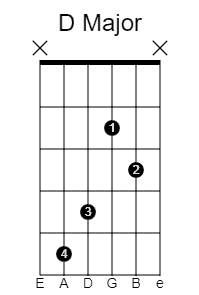

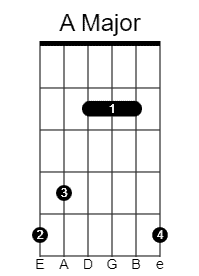
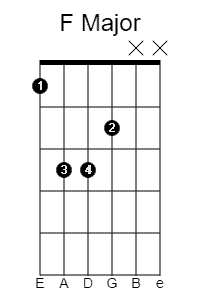
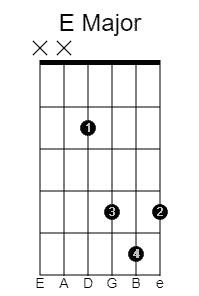
This is the same group of chords we just saw but moved up one tone, except for E, which moved just a semitone to become F.
So, in these simple chords, you can already see the power of CAGED chords and the virtually infinite sounds they can generate.
2. Cowboy Chords
Cowboy chords are the ideal complement for CAGED chords. Although there are many similitudes among them, cowboy chords (also known as open chords and first-position chords) include the CAGED chords we just saw and add some more to the list.
But why do we call them cowboy chords? Well, the reason behind the name is historic.
I will tell you half the story now and the other half when we introduce chord progressions.
One of the theories to explain the name is that, back in the day, actors played cowboys who would sit down by the fire and sing songs. While playing these scenes, actors would carelessly strum first-position chords since the actual audio of the performance didn’t make it to the final cut.
Of course, with time, it has also become somewhat of a pejorative nickname given by seasoned, academic players to pop or any other genre utilizing simple structures and basic chords.
So, history lessons and controversies apart, cowboy chords are great to kickstart your playing because will help you play a plethora of songs with minimal effort.
Yes, along with CAGED chords, the chords in this category make the best ROI you can get.
Beware, the cowboy chords we’ll see now are just those we haven’t seen when talking about CAGED chords. Therefore, you should add those to this list.
Let’s take a look at these new chords to add to the list:
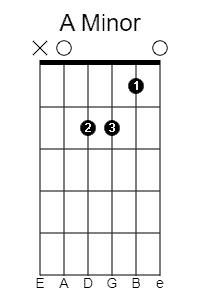


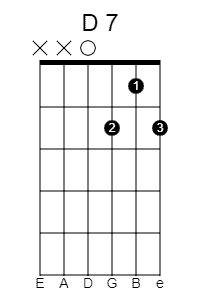
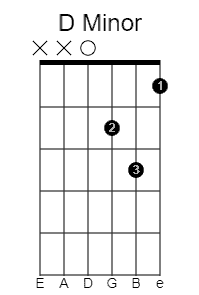

As you might have noticed, cowboy chords are united by something that’s different from their chord quality (AKA major, minor, seventh). Their main characteristic is that they are chords that can be played using open strings.
So, in this new set of chords, we have a mix of minor and seventh chords that add up to the major chords we’ve seen in the CAGED system. This is not a minor difference; one note can turn the flavor of a chord completely.
In this sense, let’s divide these chords into three categories so you can understand their use better:
- Major Chords – Major chords, like the ones we’ve seen in the CAGED system, have a naturally happy, uplifting, round, and fulfilling sound. They can very often be heard in choruses and every part of a song trying to resolve tension and sound bigger. When a chord is major, you’ll see it represented by a capital letter alone; for example, C means C major.
- Minor Chords – Minor chords differ from major chords by one note. This note makes them sound sad, complex, and emotional. Usually, if major chords are used for the chorus to sound big and happy, verses are made with minor chords to create the song’s dynamics and keep the listener engaged. Minor chords are written with the same capital letter but with a little m next to it. For example, C minor is Cm.
- Seventh Chords – While minor and major chords are triads, seventh chords are made with four notes and can be either major or minor. The most important characteristic of these chords is that they can rise the tension like no other chord in this catalog and beg to be resolved by playing a major chord. When written, we add a 7 to the letter. Hence, C seventh is C7.
A single note can change the vibe of an entire chord, and hence, a song. We’ll see more about how to use these chords when we introduce chord progressions.
3. Alternative, Open–Position Chords
We’ve seen two big groups of chords that can resolve most of your guitar-playing needs. Yes, by blending cowboy and CAGED chords you get a solution for most playing scenarios.
Yet, we are lacking some of them that might surprise you in more than one song. So, you’re about to see the simplified version of difficult chords that you can use until you master barre chords or while you’re mastering them, or simply as an alternative.
You’ll see the major, minor, and seventh versions of these chords so you can play around with them and have fun.
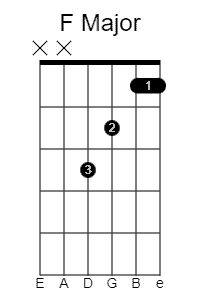


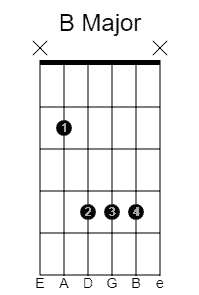

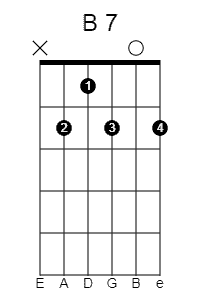
As a summary of this first part, let’s review all the chords we’ve seen so far:
That’s a total of 17 chords that will definitely kickstart your playing. Moreover, with the CAGED system we saw, you can create as many chords as you like; so that’s a very big plus to the original 17 listed here.
Chords that Go Well Together
You can think of chords like bricks. They are the bricks that can help you build songs.
Now, the type of bricks, the order, and the position will give you many different buildings or songs. This is when the music gets even more interesting because we’re about to unveil the gears that have been making most of the songs you know and love.
For that explanation, what we need is a new concept, the concept of chord progressions.
Introducing Chord Progressions
Chord progressions, just like the name implies, are chords that go well together combined to form a structure. These chords aren’t just random choices that go well together, they obey certain logic.
This logic is the logic of scales or keys, which are ways of arranging notes and chords.
Moreover, the amazing thing about chord progressions is that you can move them from one scale or key to another and, as long as you respect the intervals, you’ll get the same result.
For example, singers who want to accommodate a certain song to their register can move it to a different key and, as long as they respect the degrees in the progression, they can still perform the same song in a note that’s comfortable for them to sing.
Let’s go over the degrees of one major and one minor scale so you can be familiarized with this concept.
We’ll use C major and A minor, two scales with no sharps or flats.
| C Major Scale | ||||||
| I | II | III | IV | V | VI | VII |
| C | Dm | Em | F | G | Am | Bdim |
| A Minor Scale | ||||||
| I | II | III | IV | V | VI | VII |
| Am | Bdim | C | Dm | Em | F | G |
The key takeaways from this information are the following:
- The degrees are different in a minor or a major scale or key.
- Not every chord in a major scale is major and not every chord in a minor scale is minor.
- Every scale will give you a different set of chords to play with.
Now, let’s put all of this information to use and have some fun with the new chords we’ve just learned.
Most Famous Chord Progressions to Start With
Let’s get started with five-chord progressions that have been the recipe for countless hits and will help you play many, many songs.
I – IV – V – I – The Rock n Roll Recipe that Started it All
This chord progression is one you’ve heard a million times in your life. Remember I told you I was going to tell you the second half of the cowboy chords story later on?
Well, another reason cowboy chords got that name is because of this chord progression. Yes, this was the recipe for many early hits and, if you apply this chord progression to any major scale you will always be playing major chords.
For example, in our C major scale, we would get C – F – G – C. Therefore, we could just strum this chord progression easily within our first three frets.
Let’s see an example in major and minor using the scales above.


These are some of the many songs created using this progression:
- “Like a Rolling Stone” by Bob Dylan
- “Mr. Jones” by Simon and Garfunkel
- “Born to Run” by Bruce Springsteen
I – V – VI – IV – Rock Goes Emotional
While the progression above sounds happy and triumphant on the major scale, and sad and mysterious on the minor scale, this progression goes further into the emotional side.
Yes, we’re about to learn how to get a golden ticket straight to the heart of your listeners.
So, if we apply this progression to our C major key we get C – G – Am – F
If we apply it to our Am key, we get Am – Em – F – Dm
Let’s see what this sounds like:


These are some of the many songs created using this progression:
- “It’s my life” by Bon Jovi
- “Bullet with butterfly wings” by the Smashing Pumpkins
- “Otherside” by the Red Hot Chili Peppers
VI – I – V – II – Anybody Said Stadium Sing-along?
Stadium sing-alongs are not at all a matter of luck, there’s a recipe for success and it’s about time you know and use it. Yes, we’re about to strip these songs to their bare basics and work out the magic behind the success.
Unlike what we’ve seen so far, this progression starts higher than the tonic, in the sixth degree (VI). That is a minor change in chords that results in a major change in flavor and mood.
Applied to the C major scale, we get: Am – C – G – Dm
Applied to the Am scale, we get: F – Am – Em – B diminished
Wait, what? B diminished? How do I play that?
Let me introduce you to my friend B diminished and then we’ll see how this sounds:
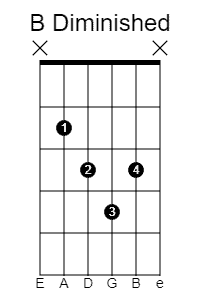


Stadiums have been singing along with these hits made using this chord progression:
- “Boulevard of Broken Dreams” by Green Day
- “Wonderwall” by Oasis
- “Pumped Up Kicks” by Foster the People
Easy Songs to use these chords straight away
Let’s finish this piece with a fun exercise. Here’s a song for each of the chord progressions we’ve seen to put this information to work.
I listed the chords for the verses and chorus (Wonderwall also has a bridge). This is for you to strum along with them until you find the rhythm and overall vibe.
Another key takeaway from this exercise is that you can understand the role of each of these chords.
Without further ado, let’s have fun!
I – IV – V – I – Like a Rolling Stone (Bob Dylan)
Perhaps, this is the most common chord progression in the history of modern Western music. This is a song that has been covered countless times including the amazing Rolling Stones version.
This is the Bob Dylan version:
Verse:
C – Dm – C – F – G
Chorus:
C – F – G – C
I – V – VI – IV – Let It Be (The Beatles)
This all-time classic by The Beatles is perfect to understand the power of that Am between the major chords in the verses and the chorus.
Verses:
C – G – Am – F
C – G – F – C
Chorus:
Am – G – F – C
C – G – F – C
VI – I – V – II – Wonderwall (Oasis)
What can be more of a stadium sing-along than this song by Brit megastars Oasis? Well, it takes the VI – I – V – II progression to its highest standard.
Verse:
Em – G – D – A7
Bridge:
C – D – Em
Chorus:
Em – C – Em – G
The Bottom Line
These chords can take your playing to the next level with minimal time and effort investment.
Yes, with these chords you can kickstart your playing but also your songwriting career since they are a vital tool to write amazing songs.
So, get familiar with these rules, and, once you’ve mastered them, feel free to break them.
There are no boundaries to music.
Happy Playing!

Hello there, my name is Ramiro and I’ve been playing guitar for almost 20 years. I’m obsessed with everything gear-related and I thought it might be worth sharing it. From guitars, pedals, amps, and synths to studio gear and production tips, I hope you find what I post here useful, and I’ll try my best to keep it entertaining also.

